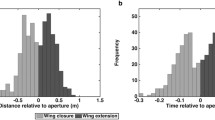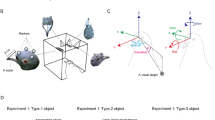Abstract
Many birds show a characteristic forward and backward head movement, while walking, running and sometimes during landing flight, called head bobbing. During the hold phase, the head of the bird remains stable in space, while during the thrust phase, the head is rapidly moved forward. Three main functions for head bobbing have been proposed: Head bobbing might have a biomechanical cause, it might serve depth perception via motion parallax, or it might be an optokinetic response that primarily serves image stabilization for improved vision during the hold phase. To investigate vision during the different phases and in particular to test for visual suppression during the saccadic thrust phase, we tested pigeons on a shape discrimination task, presenting the stimuli exclusively either in the hold phase, thrust phase or at random times. Results clearly demonstrate that shape discrimination is as good during the thrust phase as it is during the hold phase.








Similar content being viewed by others
References
Bloch S, Rivaud S, Martinoya C (1984) Comparing frontal and lateral viewing in the pigeon. III. Different patterns of eye movements for binocular and monocular fixation. Behav Brain Res 13:173–182
Brooks B, Holden AL (1973) Suppression of visual signals by rapid image displacement in the pigeon retina: a possible mechanism for ‘saccadic suppression’. Vision Res 9:1247–1258
Cronin TW, Kinloch MR, Olsen GH (2005) Head-bobbing behavior in foraging whooping cranes favors visual fixation. Curr Biol 15:R243–R244
Dagg AI (1977) Running, walking and jumping: the science of locomotion. Wykeham, London
Davies MNO, Green PR (1988) Head bobbing during walking, running and flying: relative motion perception in the pigeon. J Exp Biol 138:71–91
Davies MNO, Green PR (1991) The adaptability of visuomotor control in the pigeon during landing flight. Zool Jb Physiol 95:331–338
Dawkins MS (2002) What are birds looking at? Head movements and eye use in chickens. Anim Behav 63:991–998
Dunlap K, Mowrer OH (1930) Head movements and eye functions of birds. J Comp Psychol 11:99–113
Friedman MB (1975a) Visual control of head movements during avian locomotion. Nature 255:67–69
Friedman MB (1975b) How birds use their eyes. In: Wright P, Caryl PG, Wowles M (eds) Neural and endocrine aspect of behaviour in birds. Elsevier, Amsterdam, pp 182–204
Frost BJ (1978) The optokinetic basis of head bobbing in the pigeon. J Exp Biol 74:187–195
Goodale MA (1983) Visually guided pecking in the pigeon (Columba livia). Brain Behav Evol 22:22–41
Green PR, Cheng P (1998) Variation in kinematics and dynamics of the landing flights of pigeons on a novel perch. J Exp Biol 201:3309–3316
Green PR, Davies MNO, Thorpe PH (1994) Head bobbing and head orientation during landing flights of pigeons. J Comp Physiol 174:249–256
Hodos W, Karten HJ (1966) Brightness and pattern discrimination deficits in the pigeon after lesions of nucleus rotundus. Exp Brain Res 2:151–167
Jimenez Ortega L, Stoppa K, Güntürkün O, Troje NF (2008) Limits of intraocular and interocular transfer in pigeons. Behav Brain Res 193:69–78
Martin GR, Katzir G (1999) Visual fields in short-toed eagles, Circaetus gallicus (Accipitridae), and the function of binocularity in birds. Brain Behav Evol 53:55–66
Necker R (2007) Head bobbing of walking birds. J Comp Physiol A 193:1177–1183
Pratt DW (1982) Saccadic eye movements are coordinated with head movements in walking chickens. J Exp Biol 97:217–223
Troje NF, Frost BJ (2000) Head-bobbing in pigeons: how stable is the hold phase? J Exp Biol 203:935–940
Wallman J, Letelier J-C (1993) Eye movements, head movements, and gaze stabilization in birds. In: Zeigler HP, Bischof H-J (eds) Vision, brain, and behaviour in birds. The MIT Press, Cambridge, pp 245–263
Wohlschläger A, Jäger R, Delius J (1993) Head and eye movements in unrestrained pigeons (Columba livia). J Comp Psychol 107:313–319
Author information
Authors and Affiliations
Corresponding author
Rights and permissions
About this article
Cite this article
Jiménez Ortega, L., Stoppa, K., Güntürkün, O. et al. Vision during head bobbing: are pigeons capable of shape discrimination during the thrust phase?. Exp Brain Res 199, 313–321 (2009). https://doi.org/10.1007/s00221-009-1891-5
Received:
Accepted:
Published:
Issue Date:
DOI: https://doi.org/10.1007/s00221-009-1891-5




